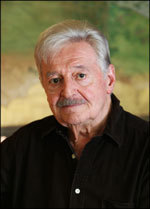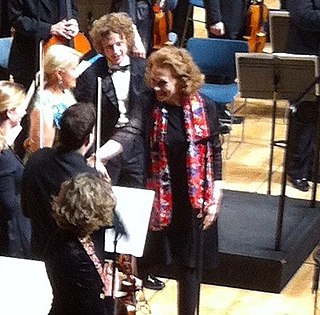
Opera Australia is the principal opera company in Australia. Based in Sydney, New South Wales, its performance season at the Sydney Opera House accompanied by the Opera Australia Orchestra runs for approximately eight months of the year, with the remainder of its time spent at the Arts Centre Melbourne, where it is accompanied by Orchestra Victoria. In 2004, the company gave 226 performances in its subscription seasons in Sydney and Melbourne, Victoria, attended by more than 294,000 people.

Peter Joshua Sculthorpe was an Australian composer. Much of his music resulted from an interest in the music of countries neighbouring Australia as well as from the impulse to bring together aspects of Aboriginal Australian music with that of the heritage of the West. He was known primarily for his orchestral and chamber music, such as Kakadu (1988) and Earth Cry (1986), which evoke the sounds and feeling of the Australian bushland and outback. He also wrote 18 string quartets, using unusual timbral effects, works for piano, and two operas. He stated that he wanted his music to make people feel better and happier for having listened to it. He typically avoided the dense, atonal techniques of many of his contemporary composers. His work was often characterised by its distinctive use of percussion. As one of the compositional pioneers of a distinctively Australian sound, Sculthorpe and his music have been likened to the role played by Aaron Copland in America's musical coming of age.

Kaija Anneli Saariaho was a Finnish composer based in Paris, France. During the course of her career, Saariaho received commissions from the Lincoln Center for the Kronos Quartet and from IRCAM for the Ensemble Intercontemporain, the BBC, the New York Philharmonic, the Salzburg Music Festival, the Théâtre du Châtelet in Paris, and the Finnish National Opera, among others. In a 2019 composers' poll by BBC Music Magazine, Saariaho was ranked the greatest living composer.

Azaria Chantel Loren Chamberlain was a nine-week-old Australian baby girl who was killed by a dingo on the night of 17 August 1980 during a family camping trip to Uluru in the Northern Territory. Her body was never found. Her parents, Lindy and Michael Chamberlain, reported that she had been taken from their tent by a dingo. However, Lindy was tried for murder and spent more than three years in prison. Michael received a suspended sentence. Lindy was released only after Azaria's jacket was found near a dingo lair and new inquests were opened. In 2012, 32 years after Azaria's death, the Chamberlains' version of events was officially supported by a coroner.

Lazar "Larry" Sitsky is an Australian composer, pianist, and music educator and scholar. His long term legacy is still to be assessed, but through his work to date he has made a significant contribution to the Australian music tradition.
Carl Edward Vine, is an Australian composer of contemporary classical music.

Richard James Gill was an Australian conductor of choral, orchestral and operatic works. He was known as a music educator and for his advocacy for music education of children.
Richard John Mills is an Australian conductor and composer. He was the artistic director of Victorian Opera from 2013-2023, and formerly artistic director of the West Australian Opera and artistic consultant with Orchestra Victoria. He was commissioned by the Victoria State Opera to write his opera Summer of the Seventeenth Doll (1996) and by Opera Australia to write the opera Batavia (2001).

Ross Edwards is an Australian composer of a wide variety of music including orchestral and chamber music, choral music, children's music, opera and film music. His distinctive sound world reflects his interest in deep ecology and his belief in the need to reconnect music with elemental forces, as well as restore its traditional association with ritual and dance. He also recognises the profound importance of music as an agent of healing. His music, universal in that it is concerned with age-old mysteries surrounding humanity, is at the same time connected to its roots in Australia, whose cultural diversity it celebrates, and from whose natural environment it draws inspiration, especially birdsong and the mysterious patterns and drones of insects. As a composer living and working on the Pacific Rim, he is aware of the exciting potential of this vast region.

Jonathan Anthony Rose is an Australian violinist, cellist, composer, and multimedia artist. Rose's work is centered in the experimental music known as free improvisation, where he has created large environmental multimedia works, built experimental musical instruments, and improvised violin concertos with accompanying orchestra. He has been described by Tony Mitchell as "undoubtedly the most exploratory, imaginative and iconoclastic violin player who has lived in Australia".

David Hobson is an Australian opera tenor and composer.
Judith Catherine Rodriguez was an Australian poet. She was a recipient of the Christopher Brennan Award.
Andrea Molino is an Italian composer and conductor.

George Dreyfus AM is an Australian contemporary classical, film and television composer.

Jacqueline Lisa Dark was an Australian operatic mezzo-soprano who appeared mainly with Australian companies, for a while as a member of Opera Australia. She was known for her voice in leading roles, including world premieres, but also for her stage presence and "a unique sense of comic timing".
Martin Wesley-Smith was an Australian composer with an eclectic output ranging from children's songs to environmental events. He worked in a range of musical styles, including choral music, operas, computer music, music theatre, chamber and orchestral music, and audiovisual pieces which bring words, music and images together. He often worked with his librettist brother, Peter Wesley-Smith.
Lindy is an opera in two acts by Australian composer Moya Henderson to an English libretto by Judith Rodriguez. It is based on the death of Lindy and Michael Chamberlain's baby Azaria Chamberlain in the Australian outback at Uluru in 1980.
Liza Lim is an Australian composer. Lim writes concert music as well as music theatre and has collaborated with artists on a number of installation and video projects. Her work reflects her interests in Asian ritual culture, the aesthetics of Aboriginal art and shows the influence of non-Western music performance practice.
Joan Carden AO OBE is an Australian operatic soprano. She has been described as "a worthy successor to Dame Nellie Melba and Dame Joan Sutherland" and was sometimes known as "the other Joan" or "The People's Diva". She was a Principal Soprano with Opera Australia for 32 years, and was particularly associated with the title roles of Giacomo Puccini's Tosca and Madama Butterfly. However, she sang over 50 other roles, from the 18th century, including virtually all the Mozart heroines, through to works by contemporary composers.

Australian classical music has developed from early years in the Australian colonies, until today. Today, each state has an orchestra and there are many major venues where classical music is performed.











